Many plants don’t just drop off dead once the frost settles over the land–which is where winter gardening comes in. You may think that once the snow comes, there’s not much gardening that you can do, but that’s not necessarily the case.

In this post, we’ll talk about all things related to winter gardening. We’ll define the term, show you how to get more out of your garden in wintertime, and explore some popular winter gardening ideas to inspire you.
So, got your shovel ready? You’ll need it, not so much for shoveling the snow as for doing some serious planting.
What Is Winter Gardening?
Winter gardening means planting cold-hardy crops and plants to enjoy them in winter. Certain crops can be planted late in the year and reach maturity before the cold sets in–we’ll explore some of them later on in this post.

Certain flowers too can do well in winter if planted at the right time and taken proper care of. It’s just a question of knowing which of them to plant and when to do it.
As you may imagine, winter gardening doesn’t mean planting things in the middle of winter or worrying about pruning the flowers after the frost has covered them.
There’s no complicated science behind winter gardening–only making the right choices at the right time.

Just to be clear here, by winter gardening we don’t mean growing plants inside your house in pots or containers. We’d be cheating if we did!
We’ve written several guides dedicated to growing flowers or vegetables indoors–check them out if all you want to do is grow some flowers indoors.
One thing to consider before you read on is how much snow you get in winter. Usually, it’s the cold that’s killing the plants–the snow acts as a kind of insulating blanket protecting the plants.

But if you get heavy snowfalls in winter–think knee-tall or higher–you’ll be more limited in your winter gardening options. For instance, you’ll probably be better off investing in a greenhouse than in raised garden beds.
How to Get More Out of Your Garden in Winter
Most gardens are not created with winter in mind. Many gardeners in fact don’t worry all that much about their outdoor plants once the cold settles in. Instead, they turn their attention to their indoor plants.
But preparing your garden for winter isn’t all that hard. You don’t have to redesign it, change the soil, or replace the plants already growing in it.

You do have to make some free space if you don’t have it already for winter plants. But other than that, it’s just a question of understanding the needs of plants in winter.
Mulch
Mulch is very important when it comes to winter gardening. It protects the roots of the plants from freezing and helps keep the soil insulated.
Whether we’re talking about plants that you already have in your garden or new ones that you plan to add, mulch is your friend. It’s relatively inexpensive, readily available, and easy to use.

The best mulch for garden includes bark (both shredded and chips), loose organic materials with a coarse texture, and straw. We suggest having a good supply of mulch ready, especially if you’re used to harsh winters.
Cold Frame
A cold frame is a way to cover plants in winter to protect them from the snowfall and lessen the impact of the cold on them. DIY cold frames are cheap to build with readily available materials so you can adapt them to your space.

Cold frames are enclosures usually made of wooden walls and transparent roofing. They lie low on the ground and have a higeable roof that stays closed while you are not inspecting the plants.
While cold frames can be pretty, many gardeners use them exclusively for their utility. If you have an unused area in your backyard, close to a wall or fence, for example, you can install there a cold frame.
Tip: Remember that plants grown in cold frames still need sunlight so try to find a spot where they get it. Avoid placing a cold frame in the shade.
Hoop Tunnel
Next come hoop tunnels. Also called quick hoops, these are low tunnels typically with a metal structure wrapped up in clear film plastic foil.
They are an inexpensive alternative to a greenhouse and can be permanent or temporary.

Hoop tunnels can be taller than cold frames which makes them more suitable for plants that grow big. If you don’t have any wood to spare, you may find building a hoop tunnel easier. You can also buy one ready-made.
In spring, you can use hoop tunnels to grow seedlings or to accustom plants grown indoors to outside temperatures before planting them in the garden.
Hot Bed
A hot bed is an old but still very relevant method to speed up plant growth. Traditionally, it’s been used to grow seedlings, but in recent years it’s seen new applications, including winter gardening.
A hot bed uses manure as a heat source. More specifically, fresh strawy manure in a big and thick layer. Don’t be uneasy–it’s a very smart way to do winter gardening because the manure generates heat as it breaks down.

The heat keeps the plants warm. Not only that, but it can also speed up their growth. You can use hot beds to grow cold-season vegetables that you can harvest within weeks after sowing them.
Most hot beds consist of a wooden frame with a transparent roof–plastic or glass. But you can get creative with the design and repurpose an old container. You can even use a barrel. Whatever works for you, really.

Whatever you use, the hot bed is going to be taller than your average cold frame because of the deep layer of manure. This should be at least 60cm deep and preferably deeper.
If you can get manure from your animals or another reliable source, you should definitely try out this approach to winter gardening.
Greenhouse
Of all the winter gardening ideas we’ve mentioned so far, the most reliable and the one that usually yields the most bountiful crops is using a greenhouse.
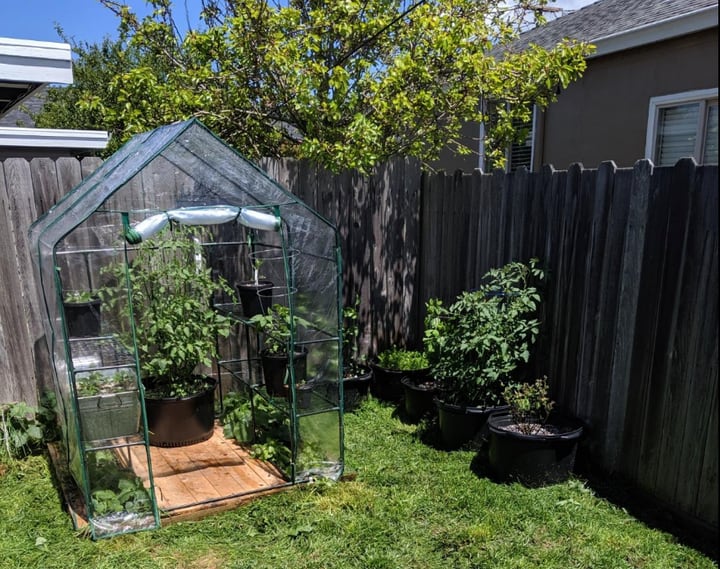
More than providing shelter for your plants, a greenhouse creates good conditions for plants to thrive in.
Building a greenhouse doesn’t have to break the bank. Using clear plastic film instead of glass and PVC instead of a metal frame can save you money. What will add to your costs is installing a heating system–but that’s not a must.
You can also buy a small greenhouse online to save yourself the trouble of building it. We’ve written a complete guide on small greenhouses.
You may also want to read more about the benefits of a greenhouse before deciding whether it’s the right choice for you.
Popular Winter Gardening Ideas
Now let’s explore some winter gardening ideas to get you started. We’ve put together lots of different ideas, from the best vegetables and winter plants to grow outside to cold frame, raised bed, and container ideas.
Let’s get right on to it!
Raised Bed Winter Gardening Ideas
Raised bed winter gardening makes growing crops or flowers in winter so much easier.
These raised beds usually rely on the cold frame or hoop tunnels we discussed in the section above. Building a raised bed for winter is neither hard nor expensive.
1. Hoop Tunnel Winter Gardening
Whether we’re talking about hoop tunnels for veggies or leafy greens (we’ll get more specific later on), this type of raised bed can be adapted to your space.
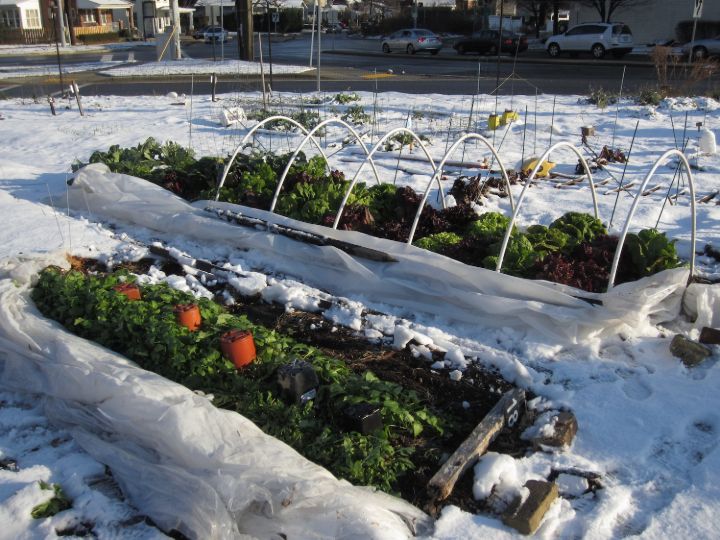
You may want to divide your crops and plants between multiple tunnels to give them enough space to grow. Notice how in this example upturned pots provide additional protection for the plants.
2. Uncovered Winter Gardening Raised Beds
If you choose to grow winter hardy plants, you don’t necessarily have to cover the raised beds–especially if you don’t get heavy snowfalls.

Place your uncovered raised beds in a geometrical arrangement like in this example to make them easy to inspect and, if needed, to water.
3. Large Winter Gardening Hoop Tunnels for Leafy Greens
If you’re serious about your winter gardening crop production, go for a wide hoop tunnel that offers enough space for you to plant in double rows.
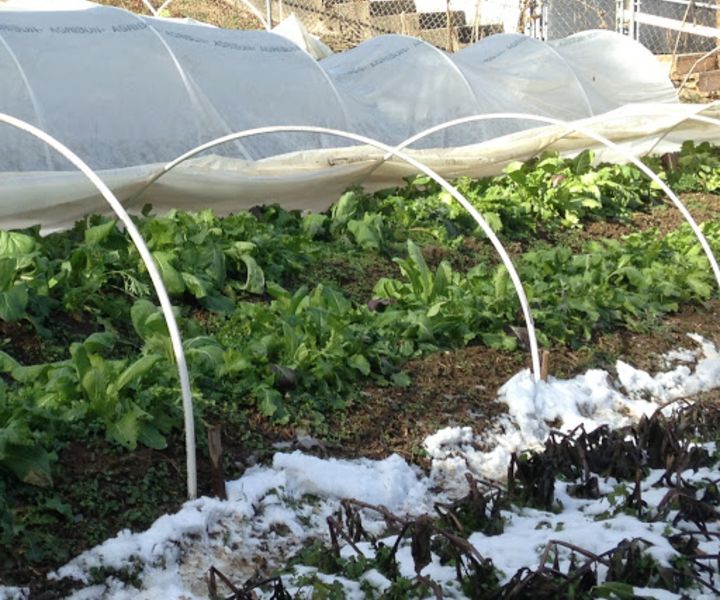
You can use this method to grow leafy greens during the early part of winter, especially in areas where temperatures don’t drop very much in winter.
4. Cold Frame Winter Gardening
But if you’re looking for something smaller, try a cold frame that you can build yourself from wood. This is perfect for hardy herbs, leafy greens, and other small crop plants.

You can build a wooden cold frame with a hinged roof like in this example without much trouble. It’s a good choice if you don’t have all that much space in your garden for winter-hardy crops.
Winter Vegetables to Grow Outdoors (And Fruits)
Some vegetables are better suited for growing in winter than others. That’s something worth remembering as choosing the right winter crops will make your winter gardening a lot easier.
It will also reduce or sometimes even eliminate the need to invest extra money to build additional structures.
5. Cabbage Winter Growing
Cabbage is a popular choice for gardeners because it’s not very demanding in terms of soil or anything else. You can also plant it quite close together, as in our example.
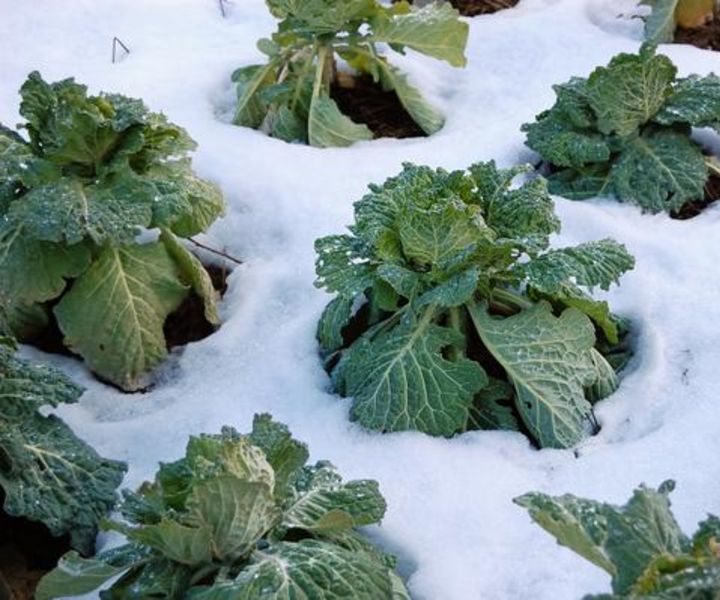
You can leave it outside uncovered and easily harvest it once the temperatures get too cold.
6. Spinach Winter Crop
One of the healthiest veggies on the planet can grow in your winter garden as well–spinach. This leafy green is cold hardy and you can plant it even in winter if the climate allows it.
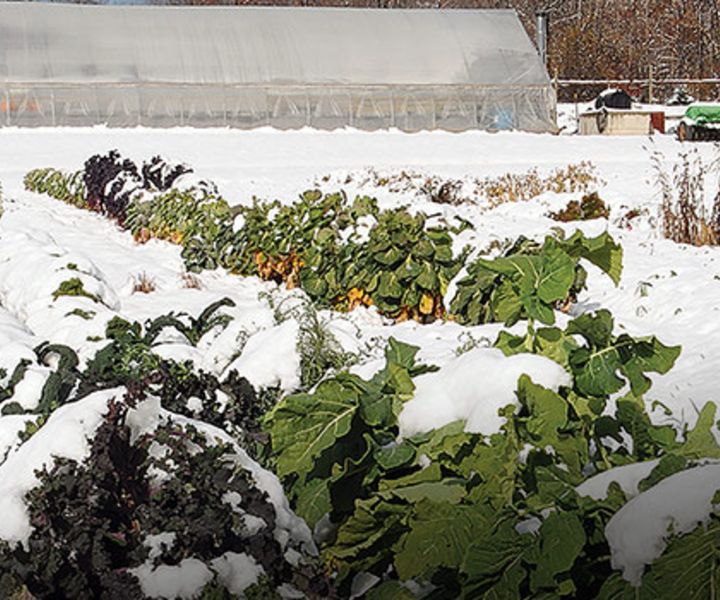
We recommend planting it in early fall so you can harvest it in early winter. Don’t forget that spinach is more nutritious than lettuce.
7. Onions Winter Gardening
You can plant onions throughout winter so long as you can work the ground. The frost won’t kill them but if you plant them late they may not grow until spring.

If you plant them in the fall, you can harvest them before or after the first frost and then replant some bulbs in the spring.
Tip: You can also leave mature onions in the ground in winter–they will multiply and you can then separate the sections and replant them.
8. Kale Winter Garden
Kale’s another favorite winter crop. If you live in a region with mild winters, you definitely want this leafy green in your garden.

But if winters there are cold and very snowy, plant kale in a hoop tunnel, cold frame, or greenhouse to enjoy it throughout the winter season.
9. Lettuce Winter Garden
Lettuce is a reliable winter crop that grows best in cool weather. You can sow it late in the garden and not worry too much that the cold will kill your crop.

Tip: Protect your lettuce from harsh winter winds as these may easily damage it. Ideally, you want to place it in a sheltered spot.
10. Peas Winter Crop
Peas pack a nice amount of protein for a veggie and it’s often one of the most accessible greens for kids and people who are not into vegetables.
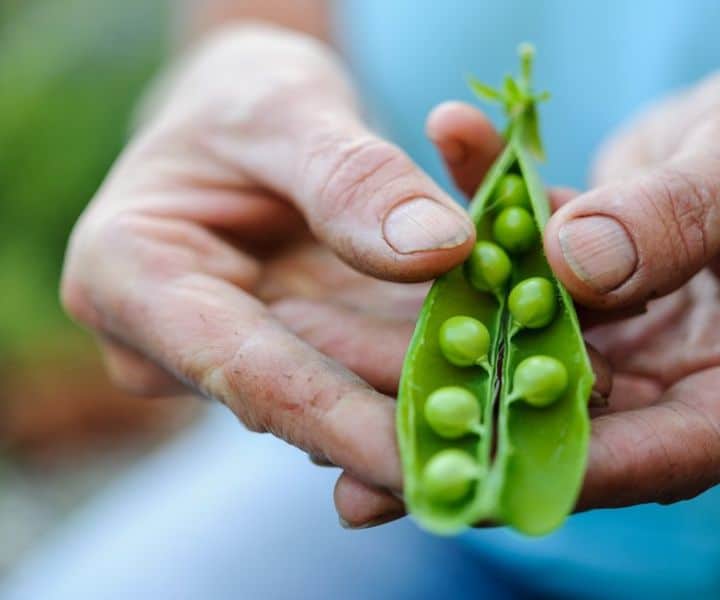
You can sow peas until about mid fall–you just want to give them some time to become established before winter. You can then enjoy them in early spring after the last frost thaws.
11. Garlic Winter Planting
Garlic’s not just one of the healthiest things you can eat, but also an awesome winter crop. If you plant it properly, it can withstand -30 degrees Fahrenheit–pretty cool, right?
Garlic needs cold weather for the bulbs to start growing in spring.

Plant garlic in the fall. Don’t wait until winter is knocking at your garden gate–give the plant a bit of time to become established and survive winter. This will ensure healthier growth as well as larger bulbs.
12. Broccoli Winter Crop
Are mild winters the norm where you live? That means you can plant broccoli in the fall and harvest it in winter–just in time to enjoy all of its health-boosting nutrients.
In other words, frozen broccoli straight from your vegetable garden, without plastic packaging, too!

But if winter there tends towards blizzards and stone-cracking temperatures, plant broccoli by late fall or slightly earlier to harvest it early in winter, before the chill has a chance to damage the plant.
Tip: If you won’t be eating all your broccoli winter crop right away, you may want to freeze it for storage in reusable plastic bags. That way you can preserve most of its nutrients.
13. Strawberry Winter Crops
Strawberry plants can handle below freezing temperatures but need protection from frost.
The easiest way to protect strawberries in winter is to cover them with a layer of mulch. Don’t hurry to cover them too soon, though–wait for them to be fully dormant.

Tip: You can plant strawberry plants up until about six weeks before the last frost. If you have any free area in your garden, go ahead and plant some while the soil is easy to work.
Winter Gardening Cold Frame Ideas
We talked about cold frames earlier–now let’s explore some examples that you can build in your garden or yard.
Don’t forget that you can always adapt them to your needs and use alternative materials if that makes your work easier.
14. Glass Roof Large Cold Frame
This cold frame combines the raised bed with a hinged glass roof paneling to provide ample space for you to grow leafy greens, herbs, and vegetables. But this example is not just for winter gardening.
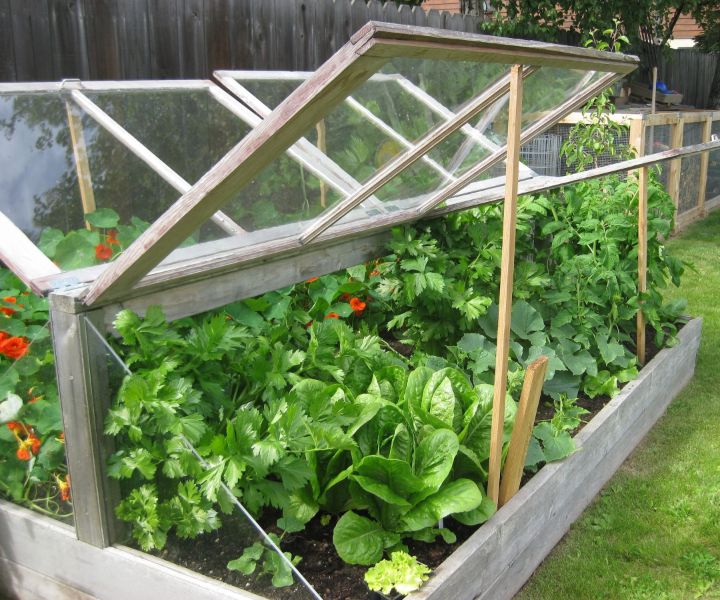
You can use this cold frame to protect your crops from inclement weather throughout the year as well as to speed up the growth of seedlings or accustom plants to outdoor conditions before transplanting them.
15. Plastic Bottles Winter Gardening
A common way to protect plants during cold weather and winter especially is to cover them with a plastic container–a halved plastic bottle, like in the example below.

Remember that the plants still need to breathe, so while the weather’s good, you can leave the bottles uncapped. We recommend you use big bottles to give the plants enough space to grow.
16. Low Hoop Tunnel Winter Garden
Low but long–this kind of hoop tunnel can provide the much needed protection that your winter plants need. It’s great for veggies and leafy greens.
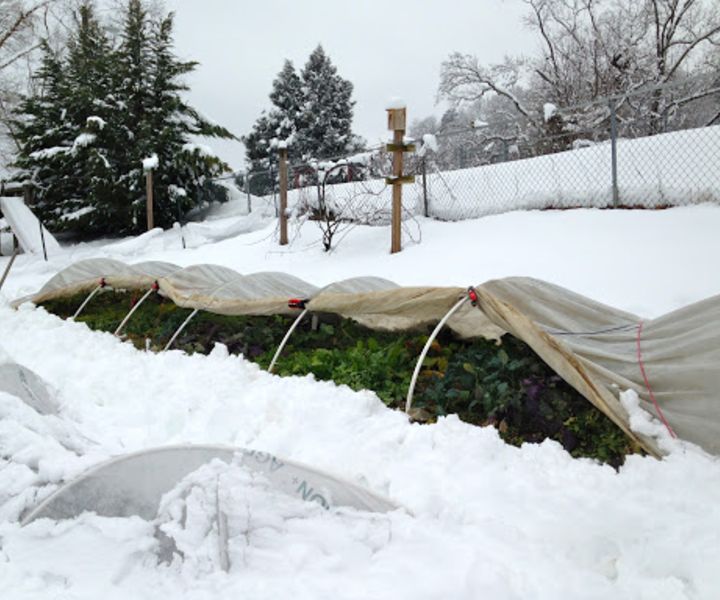
Keep in mind though that this works for plants that don’t grow tall–those will do better in a glasshouse or a similar spacious structure.
17. Large Cold Frame Winter Gardening
Cold frames can provide more light than a greenhouse or hoop tunnel covered with plastic film.
That can be an advantage if you want to create optimal conditions for your plants to become established before the worst of winter comes.

Hinged cold frames like the one in this example are a winter gardener’s best friend and can last a long time if they’re well positioned and properly handled.
18. Single Wooden Cold Frame
But if you’re new to winter gardening or just don’t want to grow all that many winter crops, you can keep things simple. A single cold frame made from wood like the one in this example can be just what you need.

You can build it from readily available materials to create a sheltered space for your favorite leafy greens and herbs.
Tip: The rooftop doesn’t always have to be made from glass. You can choose instead transparent polycarbonate or a comparable material for a lower cost and easy replacement.
Winter Gardening Container Ideas
Another way to do winter gardening is to use containers. When used for cold-hardy plants, containers can keep the roots well above the ground.
They also enable you to position the plants in a spot where they are safe from harsh winds.
19. Metal Buckets Winter Gardening
Metal containers are cold-resistant–you don’t have to worry that they will crack or withstand any other type of cold damage.

They are also spacious and blend into most types of settings.
20. Elegant Stone Containers
If you’re looking for something more elegant, try out stone containers.

These keep the plants well above the soil and are perfect for evergreens and large plants. You can use them as centerpieces.
Flower Winter Gardening Ideas
It’s not just vegetables and herbs that you can grow in winter. Some flowers are cold hardy and will not mind poking their colorful heads out of a decent layer of snow. So, what flowers can you grow in winter?
21. Aconites Winter Gardening
Aconites have beautiful yellow heads that create a beautiful contrast with the snow. These are tubers and need to be planted about 5 inches deep so the frost won’t harm the roots. The best time to plant them is usually in late fall.
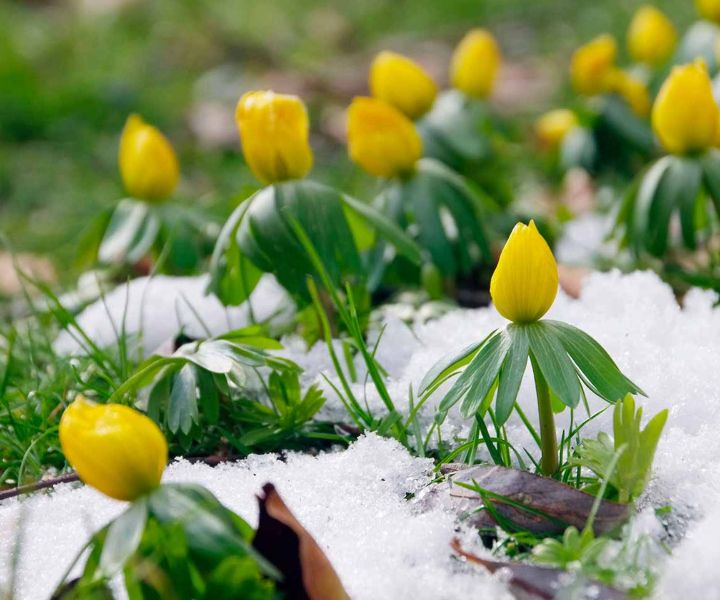
Aconites are popular winter flowers but you have to be careful–they can grow very fast and spread over the garden. Keep this in mind especially when you plant them through seed.
22. Camellias Winter Gardening
Great news–camellias bloom in winter. These beautiful flowers not only survive the chill, but put on bright petals.
Camellias are evergreen shrubs. If you’re serious about winter gardening, we recommend having at least one in your garden.

Tip: Use compost and mulch to protect the roots of the camellias. If the temperatures rise, make sure to water them in the morning.
23. Crocus Winter Gardening
Another flower that’s a favorite with many winter gardeners is the crocus.
This flower may look delicate, but both its leaves and petals can survive the winter chill. The best reason to plant these is that they will come back for years.

Tip: Plant crocus bulbs (corms) in late summer to give them time to become established.
24. Pansy Winter Garden
Another inspired choice for your winter garden is the pansy. You’re looking at a hardy plant that can survive a hard freeze and add serious color to your garden.
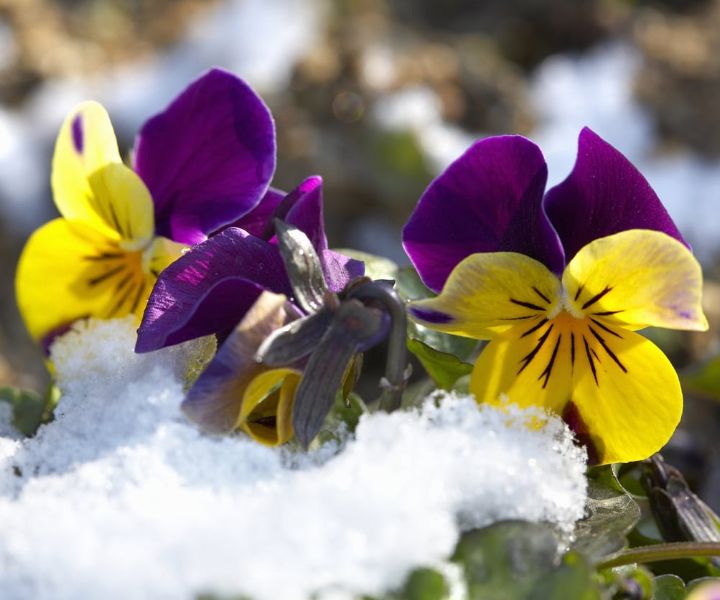
Even if the blooms may be damaged by the cold, the plant itself will remain alive and flower again. Talking of resilience!
25. Hellebores Niger
Hellebores Niger or Christmas Rose, as it’s better known, is another winter-blooming perennial that you can add to your garden if you have space for it.
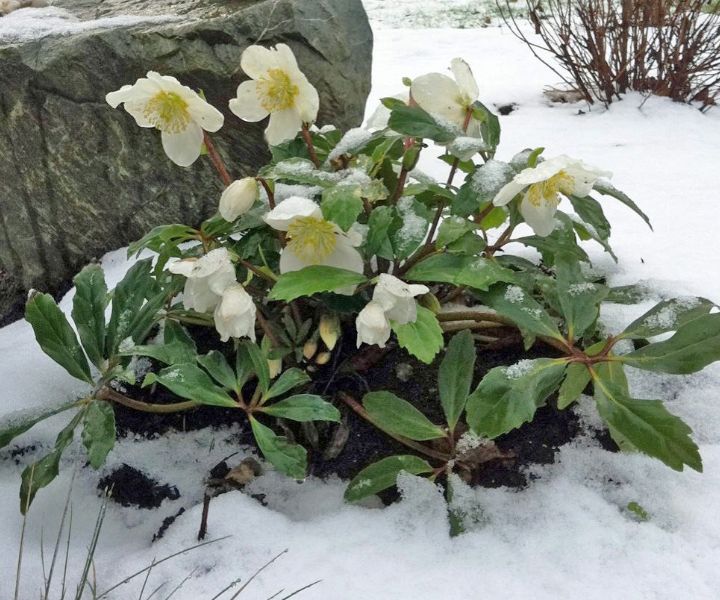
Tip: Plant it in rich and well drained soil to ensure it will thrive. You can also grow it in a spacious pot.
26. Winter Jasmine
If planted in the fall, winter jasmine can bloom in mid to late winter. This plant isn’t as smelly as other varieties of jasmine, but it can make your garden more cheerful.

Tip: Plant it in a spot where it gets plenty of sunlight. You also want to prune it in spring to encourage growth the following season.
27. Snow Drops
You must have seen these coming! Snow drops are just about any gardener’s darlings. They are also the heralds of spring.

Snow drops can come back every year, though they may need a year or two to become established. So, make sure not to upset the spot you plant them in.
28. Hardy Cyclamen
This plant is different from the cyclamen that florists sell. It does well in cold climates and can survive winter but it doesn’t like hot weather.
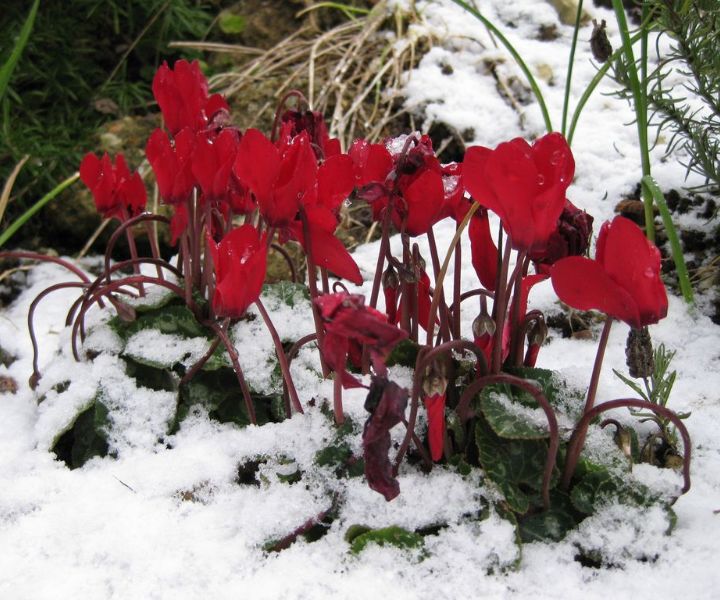
Tip: Plant it preferably in loose soil. Good drainage is also important.
29. Pieris Japonica
Flowering in late winter, Pieris Japonica is an evergreen shrub that can help you fill an empty spot in your winter garden. It does best in slightly acidic, loamy soil and needs good drainage conditions.

Warning: This plant is poisonous to dogs.
Winter Plants to Grow Outdoors
We’ve already mentioned some flowering plants you can grow in your winter garden. There are a couple of other plants you may want in there, too.
These hedges and trees are hardy and can add another layer of greenery to your space.
30. Japanese Yew
The Japanese Yew can provide color to your garden throughout the ear thanks to its cold-hardy foliage and red fruit.

Good to know: Some dwarf varieties are tiny while others can exceed 50 feet in height. Make sure to choose the right one for you!
31. Winter Gem Boxwoods
Another favorite shrub for winter gardeners, Winter Gem Boxwood can grow up to 3 feet in height if it gets enough sun.

Whether you choose to plant just one or to fill an empty area with lots of them like in this image, it’s good space filler.
32. Witch Hazel
The flame-colored witch hazel is one of the more striking winter garden plants around. Depending on the variety and how you cut it, Witch Hazel can grow into a tree or shrub.
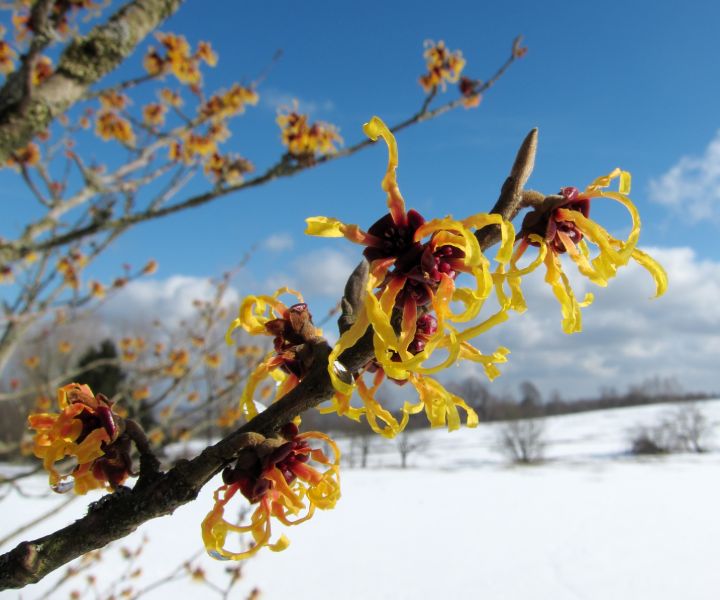
You’ll like this dense, evergreen with its interesting colors and growth habits and hardy nature, so make sure to give it a try.
33. Privet Hedge
Looking for a robust hedge? Try Privet Hedge, an unpretentious hedge that does well in winter–it may lose some foliage, but the cold won’t kill it.

Good to know: It can grow over 20 inches in a year, making it a reliable choice if you want to build a hedge wall for privacy.
Gardening in Winter Tips: How to Prepare Your Outdoor Plants for Winter
An important aspect of winter gardening is preparing your plants for the cold season. This is something you have to do in time–you can’t wait for the frost to set in.
The important thing to remember is that cooling temperatures and the decrease in sunlight will pause the growth of your outdoor plants–most of them at least.
With that in mind, you need to make sure that your plants are ready for the cold and, when necessary, protected from it.
Step 1 – Dig Out Root Crops Before the Ground Freezes

Remove tomato, pumpkin, pea, or bean plants and dispose of them. Carrots, potatoes, beets, or turnips can survive a frost. Leaving them in the soil into early winter may in fact improve their taste.
But you want them out before the first frost to prevent damage from the cold. Make sure to store these properly in the pantry, shed, or basement.
Leafy greens can get better with a light frost too, but you want them removed as well.
That leaves herbs. Herbs like thyme or sage are hardy, but basil or rosemary won’t survive winter. You may have to dig out and bring some herbs indoors.
Step 2 – Clean and Till the Soil
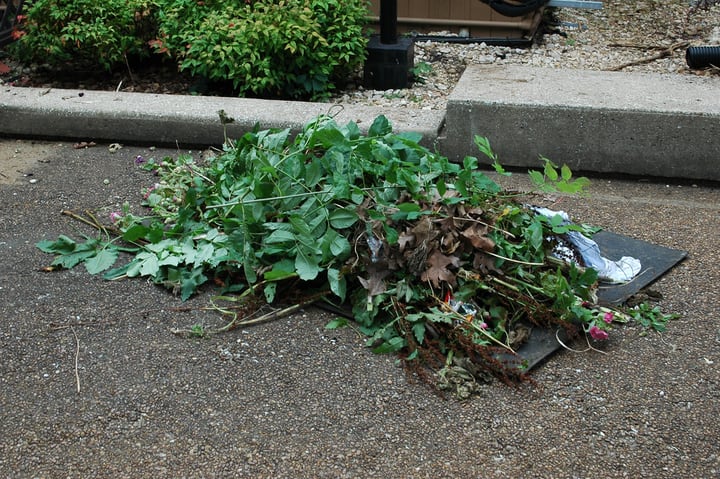
Next, you want to remove weeds and plant leftovers and then lightly till the soil to reduce potential pests during the next growing season.
If you have to remove lots of weeds, simply cover them with a durable plastic film layer and let that in place through the winter–by spring they will be gone.
Step 3 – Add Compost or Sow Cover Crops

Add compost to the tilled soil to prepare it for planting next year. An alternative to this is to plant cover crops that can improve soil quality, like winter rye.
Step 4 – Water and Cut Back Perennials

Keep watering your perennials before the temperatures drop below freezing. Once the ground freezes, cut them to about 3 inches.
You can add some mulch to them and to any areas where you want to create a flower bed. Apply the same treatment to flowering shrubs.
Tip: Read our guides on wintering chrysanthemums or geraniums.
Step 5 – Wrap Up the Trees and Shrubs That Need It

Remove broken branches and limbs from the trees and then wrap up young trees and shrubs in a warm layer of straw or shredded leaves and foil. While you’re at it, you may also want to move potted plants to a sheltered place.
How to Water Your Winter Garden
During winter, plants are dormant but not dead. They still need water to stay alive and, depending on the climate in your region and the amount of snowfall you’re getting, there may not be enough water in the soil for them.
Should you water your winter garden? Often, the answer is yes because the roots of the plants dry in winter.
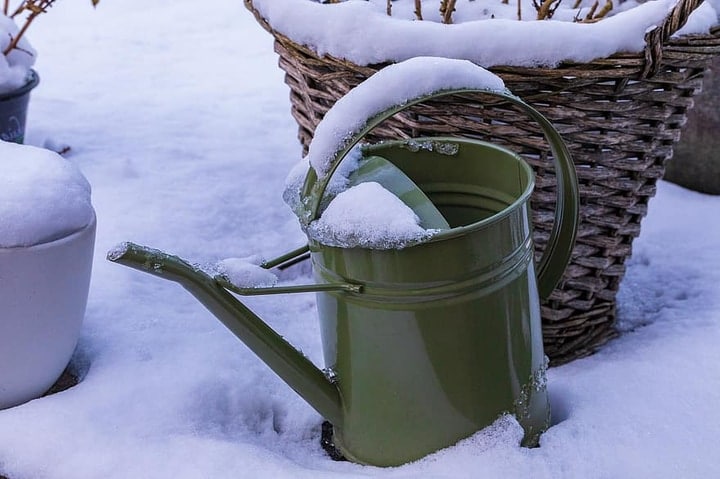
But there’s no universal answer to this question. If you don’t get much snowfall in winter, it’s a good idea to water your garden.
Dry winds may also deplete the plants of the moisture they need to stay alive in winter. If dry winds are common in your region, you want to water your winter garden.
So, how exactly should you water your plants in winter? Here are some things to keep in mind.
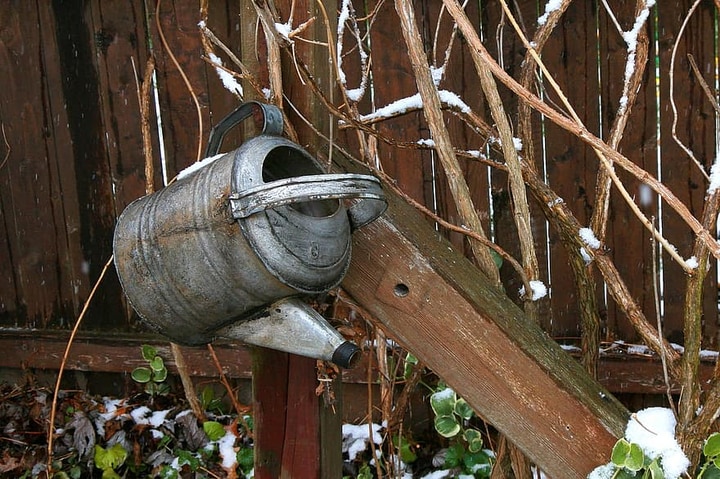
- Don’t water when the temperature is below 4 degrees Fahrenheit.
- Water only if the soil is dry and avoid soggy soil that can damage the roots of the plants.
- Water your plants in the first part of the day when the temperatures are near freezing.
- Water your plants less than you would during the warmer seasons as plants don’t need that much water in winter. One exception to this may be winter-blooming plants in mild climates.
- Water small plants near the crown and trees and bushes near the trunk.
- Avoid watering your garden plants while the wind is blowing.
Best Winter Gardening Books
Reading more about winter gardening can help you get better results and use the resources you already have more effectively.
If you have the time, grab a book or two on winter gardening to add to what you’ve already learned about planting and caring for plants in winter.
Here are some bestsellers on the subject you may want to check.
Winter Gardening Frequently Asked Questions
We’ve heard quite a bit of talk about winter gardening lately–gardeners have plenty of questions about it.
So we thought it would be helpful to our readers to put together the most frequent questions we hear in this section. Explore now the answers.
Can you start a garden in the winter?

Yes, you can start a garden in winter. Having a cold frame, hoop tunnel, or glasshouse will make it easy.
Depending on your region and the temperatures you’re getting, you could even dig new beds and prepare some crops and plants for spring and summer.
Explore our winter gardening ideas to get inspired.
What can you grow in a winter garden?

Lots of plants and flowers can grow in a winter garden. Vegetables you can grow in winter include cabbage, kale, carrots, cauliflower, beets, broccoli, or Brussel sprouts.
Winter flower plants include winter honeysuckle and aconites, pansies, winter clematis, snowdrops, and more. Check out our list of plants you can grow in winter for more ideas.
When should I start a winter garden?

The best time to start a winter garden is around 8 weeks or so before the frost comes. Figure out the average frost date in your region and plant accordingly.
But if you plan to use a cold frame, hoop tunnel, or greenhouse, you could start even later.
How do you prepare a garden for winter?

You want to start by removing bad weeds and clearing fallen leaves and finished plants. You can then prune perennials, plant bulbs, and cover crops, and add some mulch.
Don’t forget to prepare some compost. Read our guide on how to prepare a garden for winter for more tips and ideas.
Warm Yourself Up with Winter Gardening
Winter gardening is a nice way to say no to boring winters. Whether you get lots of snow and chilling frosts or mild winters, there are plenty of ways to do winter gardening and grow crops and plants in the heart of winter.
More than the reward of the winter harvest or the beauty of the flowers poking their heads through the snow, you’ll enjoy the reward of exploring a side of gardening that not every gardener gets to know.

Few things will help you appreciate the endurance and adaptability of plants than winter gardening.
We hope you’ve enjoyed this post and that it will inspire you to do some winter gardening this year.
Have you ever tried winter gardening before? Drop us a comment and let us know. And if you have any questions, don’t hesitate to ask.

Leave a Reply